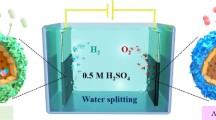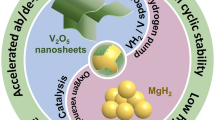Abstract
Photothermal reverse water gas shift (RWGS) catalysis holds promise for efficient conversions of greenhouse gas CO2 and renewable H2, powered solely by sunlight, into CO, an important feedstock for the chemical industry. However, the performance of photothermal RWGS catalysis over existing supported catalysts is limited by the balance between the catalyst loading and dispersity, as well as stability against sintering. Herein, we report a core-shell strategy for the design of photothermal catalysts, by using Ni12P5 as an example, with simultaneously strong light absorption ability, high dispersity and stability. The core-shell structured Ni12P5@SiO2 catalyst with a relatively small Ni12P5 particle size of 15 nm at a high Ni12P5 loading of 30 wt% exhibits improved activity, nearly 100% CO selectivity, and superior stability in photothermal RWGS catalysis, particularly under intense illuminations. Our study clearly reveals the effectiveness of the core-shell strategy in breaking the limitation of supported catalysts and boosting the performance of photothermal CO2 catalysis.

摘要
光热催化逆水煤气变换有望实现完全太阳能驱动条件下, 将 温室气体CO2和可再生H2转化为重要的化工原料CO. 然而现有负 载型光热逆水煤气变换催化剂的性能受限于催化剂负载量、分散 性、稳定性的相互制约. 本文提出了一种核壳结构策略, 并以 Ni12P5为例, 设计了同时具有强光吸收、高分散度和高稳定性的光 热催化剂. 得的Ni12P5@SiO2核壳结构催化剂在Ni12P5负载量高达 30 wt%时, 依然保持了15 nm的较小颗粒尺寸, 从而在光热催化逆 水煤气变换反应中表现出了更高的活性、接近100%的CO选择性 和极佳的稳定性, 尤其是在强光照条件下性能更加突出. 本研究揭 示了核壳策略能有效突破传统负载型催化剂的局限, 提高光热催 化CO2还原的性能.
Similar content being viewed by others
References
Ghoussoub M, Xia M, Duchesne PN, et al. Principles of photothermal gas-phase heterogeneous CO2 catalysis. Energy Environ Sci, 2019, 1: 1122–1142
Zhao Y, Gao W, Li S, et al. Solar-versus thermal-driven catalysis for energy conversion. Joule, 2019, 1: 920–937
Wang L, Zhang W, Zheng X, et al. Incorporating nitrogen atoms into cobalt nanosheets as a strategy to boost catalytic activity toward CO2 hydrogenation. Nat Energy, 2017, 1: 869–876
Chen G, Waterhouse GIN, Shi R, et al. From solar energy to fuels: recent advances in light-driven C1 chemistry. Angew Chem Int Ed, 2019, 1: 17528–17551
Li X, Sun Y, Xu J, et al. Selective visible-light-driven photocatalytic CO2 reduction to CH4 mediated by atomically thin CuIn5S8 layers. Nat Energy, 2019, 1: 690–699
Qian C, Sun W, Hung DLH, et al. Catalytic CO2 reduction by palladium-decorated silicon-hydride nanosheets. Nat Catal, 2018, 1: 46–54
Kong T, Jiang Y, Xiong Y. Photocatalytic CO2 conversion: What can we learn from conventional COx hydrogenation? Chem Soc Rev, 2020, 1: 6579–6591
Low J, Zhang L, Zhu B, et al. TiO2 photonic crystals with localized surface photothermal effect and enhanced photocatalytic CO2 reduction activity. ACS Sustain Chem Eng, 2018, 1: 15653–15661
Kang L, Liu XY, Wang A, et al. Photo-thermo catalytic oxidation over a TiO2-WO3-supported platinum catalyst. Angew Chem Int Ed, 2020, 1: 12909–12916
Wan L, Zhou Q, Wang X, et al. Cu2O nanocubes with mixed oxidation-state facets for (photo)catalytic hydrogenation of carbon dioxide. Nat Catal, 2019, 1: 889–898
Robatjazi H, Zhao H, Swearer DF, et al. Plasmon-induced selective carbon dioxide conversion on earth-abundant aluminum-cuprous oxide antenna-reactor nanoparticles. Nat Commun, 2017, 8: 27
Jia J, O’Brien PG, He L, et al. Visible and near-infrared photothermal catalyzed hydrogenation of gaseous CO2 over nanostructured Pd@Nb2O5. Adv Sci, 2016, 3: 1600189
Herron JA, Kim J, Upadhye AA, et al. A general framework for the assessment of solar fuel technologies. Energy Environ Sci, 2015, 1: 126–157
Millet MM, Algara-Siller G, Wrabetz S, et al. Ni single atom catalysts for CO2 activation. J Am Chem Soc, 2019, 1: 2451–2461
Guo S, Di J, Chen C, et al. Oxygen vacancy mediated bismuth stannate ultra-small nanoparticle towards photocatalytic CO2-to-CO conversion. Appl Catal B-Environ, 2020, 276: 119156
Xu F, Meng K, Cheng B, et al. Unique S-scheme heterojunctions in self-assembled TiO2/CsPbBr3 hybrids for CO2 photoreduction. Nat Commun, 2020, 11: 4613
Torres Galvis HM, Bitter JH, Khare CB, et al. Supported iron nanoparticles as catalysts for sustainable production of lower olefins. Science, 2012, 1: 835–838
Jiao F, Li J, Pan X, et al. Selective conversion of syngas to light olefins. Science, 2016, 1: 1065–1068
Li Z, Liu J, Zhao Y, et al. Co-based catalysts derived from layered-double-hydroxide nanosheets for the photothermal production of light olefins. Adv Mater, 2018, 30: 1800527
Wang Y, Zhao Y, Liu J, et al. Manganese oxide modified nickel catalysts for photothermal co hydrogenation to light olefins. Adv Energy Mater, 2019, 10: 1902860
Ma HC, Zhao CC, Chen GJ, et al. Photothermal conversion triggered thermal asymmetric catalysis within metal nanoparticles loaded homochiral covalent organic framework. Nat Commun, 2019, 10: 3368
Schneck F, Schendzielorz F, Hatami N, et al. Photochemically driven reverse water-gas shift at ambient conditions mediated by a nickel pincer complex. Angew Chem Int Ed, 2018, 1: 14482–14487
He Z, Cui M, Qian Q, et al. Synthesis of liquid fuel via direct hydrogenation of CO2. Proc Natl Acad Sci USA, 2019, 1: 12654–12659
Meng X, Wang T, Liu L, et al. Photothermal conversion of CO2 into CH4 with H2 over group VIII nanocatalysts: An alternative approach for solar fuel production. Angew Chem Int Ed, 2014, 1: 11478–11482
Yu F, Wang C, Li Y, et al. Enhanced solar photothermal catalysis over solution plasma activated TiO2. Adv Sci, 2020, 7: 2000204
Li Y, Walsh AG, Li D, et al. W-doped TiO2 for photothermocatalytic CO2 reduction. Nanoscale, 2020, 1: 17245–17252
Li Y, Wang C, Song M, et al. TiO2−x/CoOx photocatalyst sparkles in photothermocatalytic reduction of CO2 with H2O steam. Appl Catal B-Environ, 2019, 1: 760–770
Yan J, Wang C, Ma H, et al. Photothermal synergic enhancement of direct Z-scheme behavior of Bi4TaO8Cl/W18O49 heterostructure for CO2 reduction. Appl Catal B-Environ, 2020, 268: 118401
Yu F, Wang C, Ma H, et al. Revisiting Pt/TiO2 photocatalysts for thermally assisted photocatalytic reduction of CO2. Nanoscale, 2020, 1: 7000–7010
Zhao L, Qi Y, Song L, et al. Solar-driven water-gas shift reaction over CuOx/Al2O3 with 1.1% of light-to-energy Storage. Angew Chem Int Ed, 2019, 1: 7708–7712
O’Brien PG, Ghuman KK, Jelle AA, et al. Enhanced photothermal reduction of gaseous CO2 over silicon photonic crystal supported ruthenium at ambient temperature. Energy Environ Sci, 2018, 1: 3443–3451
Chen G, Gao R, Zhao Y, et al. Alumina-supported CoFe alloy catalysts derived from layered-double-hydroxide nanosheets for efficient photothermal CO2 hydrogenation to hydrocarbons. Adv Mater, 2018, 30: 1704663
Wang L, Wang Y, Cheng Y, et al. Hydrogen-treated mesoporous WO3 as a reducing agent of CO2 to fuels (CH4 and CH3OH) with enhanced photothermal catalytic performance. J Mater Chem A, 2016, 1: 5314–5322
Li Y, Hao J, Song H, et al. Selective light absorber-assisted single nickel atom catalysts for ambient sunlight-driven CO2 methanation. Nat Commun, 2019, 10: 2359
Feng K, Wang S, Zhang D, et al. Cobalt plasmonic superstructures enable almost 100% broadband photon efficient CO2 photocatalysis. Adv Mater, 2020, 32: 2000014
Jia J, Wang H, Lu Z, et al. Photothermal catalyst engineering: hydrogenation of gaseous CO2 with high activity and tailored selectivity. Adv Sci, 2017, 4: 1700252
Kong N, Han B, Li Z, et al. Ruthenium nanoparticles supported on Mg(OH)2 microflowers as catalysts for photothermal carbon dioxide hydrogenation. ACS Appl Nano Mater, 2020, 1: 3028–3033
Cai MJ, Li CR, He L. Enhancing photothermal CO2 catalysis by thermal insulating substrates. Rare Met, 2020, 1: 881–886
Wang L, Dong Y, Yan T, et al. Black indium oxide a photothermal CO2 hydrogenation catalyst. Nat Commun, 2020, 11: 2432
He L, Wood TE, Wu B, et al. Spatial separation of charge carriers in In2O3−x(OH)y nanocrystal superstructures for enhanced gas-phase photocatalytic activity. ACS Nano, 2016, 1: 5578–5586
Sun W, Qian C, He L, et al. Heterogeneous reduction of carbon dioxide by hydride-terminated silicon nanocrystals. Nat Commun, 2016, 7: 12553
Qi Y, Song L, Ouyang S, et al. Photoinduced defect engineering: Enhanced photothermal catalytic performance of 2D black In2O3−x nanosheets with bifunctional oxygen vacancies. Adv Mater, 2020, 32: 1903915
Hoch LB, O’Brien PG, Jelle A, et al. Nanostructured indium oxide coated silicon nanowire arrays: A hybrid photothermal/photochemical approach to solar fuels. ACS Nano, 2016, 1: 9017–9025
Fang Y, Lv K, Li Z, et al. Solution-liquid-solid growth and catalytic applications of silica nanorod arrays. Adv Sci, 2020, 7: 2000310
Xu YF, Duchesne PN, Wang L, et al. High-performance light-driven heterogeneous CO2 catalysis with near-unity selectivity on metal phosphides. Nat Commun, 2020, 11: 5149
Wang H, Tang Q, Chen Z, et al. Recent advances on silica-based nanostructures in photocatalysis. Sci China Mater, 2020, 1: 2189–2205
Ouyang R, Liu JX, Li WX. Atomistic theory of ostwald ripening and disintegration of supported metal particles under reaction conditions. J Am Chem Soc, 2013, 1: 1760–1771
Hansen TW, Delariva AT, Challa SR, et al. Sintering of catalytic nanoparticles: Particle migration or ostwald ripening? Acc Chem Res, 2013, 1: 1720–1730
Cao XQ, Zhou J, Li S, et al. Ultra-stable metal nano-catalyst synthesis strategy: A perspective. Rare Met, 2020, 1: 113–130
Acknowledgements
This work was financially supported by the National Natural Science Foundation of China (51802208, 51920105005, 21902113, 51821002 and 91833303), the Natural Science Foundation of Jiangsu Province (BK20200101), the Collaborative Innovation Centre of Suzhou Nano Science & Technology, and the Priority Academic Program Development of Jiangsu Higher Education Institutions (PAPD). Ozin G is grateful to the Natural Sciences and Engineering Council of Canada for support of this work.
Author information
Authors and Affiliations
Contributions
He L, Ozin G, Li C and Zhang X conceived and designed the experiments. Lou D, Zhu Z and Xu YF carried out the synthesis of materials. Lv K, Zhang D, Wu Z and Zhang C performed the characterizations. Lou D, Zhu Z and Feng K carried out the catalytic testing. Lou D, Li C, Zhu Z and He L wrote the paper. All the authors contributed to the data analysis, discussed the results, and commented on the manuscript.
Corresponding authors
Additional information
Conflict of interest
The authors declare that they have no conflict of interest.
Supplementary information
Supporting data are available in the online version of the paper.
Deyue Lou is currently a Master student at FUNSOM, Soochow University. Her research interest focuses on the photothermal catalytic reduction of carbon dioxide.
Zhijie Zhu is currently a PhD student at FUNSOM, Soochow University. His research interest focuses on the photothermal catalytic reduction of carbon dioxide.
Yang-Fan Xu received his Bachelor and PhD degrees from Sun Yat-sen University in 2013 and 2018, respectively. He is now a post-doctoral fellow at the University of Toronto, and his current research interest focuses on the light-driven catalytic CO2 hydrogenation for solar-fuel production.
Chaoran Li received his Bachelor’s degree from Xiamen University and his doctorate degree from Fujian Institute of Research on the Structure of Matter. From 2015 to 2020, he was a postdoctoral researcher at Soochow University. He then joined FUNSOM, Soochow University, as an associate professor. His research interest focuses on controlled synthesis of low-symmetry nanostructures and their applications in photothermal CO2 reduction.
Geoffrey A. Ozin is a Distinguished University Professor at the University of Toronto and the Government of Canada Research Chair in materials chemistry and nanochemistry. He currently spearheads the Solar Fuels Team at the University of Toronto. He has held positions as Honorary Professor at The Royal Institution of Great Britain and University College London, External Adviser for the London Centre for Nanotechnology, Alexander von Humboldt Senior Scientist at the Max Planck Institute for Surface and Colloid Science and the Center for Functional Nanostructures at the Karlsruhe Institute of Technology, and Global Chair at Bath University.
He Le received his Bachelor’s degree from Nanjing University and his doctorate degree from the University of California Riverside. From 2013 to 2015, he was a postdoctoral researcher at the University of Toronto, Canada. In 2015, he joined FUNSOM, Soochow University as a professor. His main research interest focuses on the development of functional nanostructured materials for various demanding applications, especially heterogeneous CO2 photocatalysis.
Rights and permissions
About this article
Cite this article
Lou, D., Zhu, Z., Xu, YF. et al. A core-shell catalyst design boosts the performance of photothermal reverse water gas shift catalysis. Sci. China Mater. 64, 2212–2220 (2021). https://doi.org/10.1007/s40843-020-1630-2
Received:
Accepted:
Published:
Issue Date:
DOI: https://doi.org/10.1007/s40843-020-1630-2




